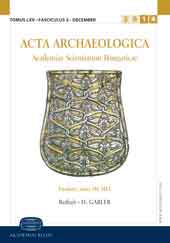POLGÁR 1: L’HABITAT DU SECOND AGE DU FER (III e SIECLE AV. J.-CHR.)
POLGÁR 1:IRON AGE SETTLEMENT (3RD CENTURY BC).
Author(s): Miklós Szabó, Zoltan Czajlik, Károly Tankó, Lajos TímárSubject(s): Archaeology, Cultural history, Agriculture, Historical Geography, Ancient World
Published by: Akadémiai Kiadó
Keywords: Late Iron Age; rural settlement; Celtic culture; Great Hungarian Plain;
Summary/Abstract: The Celtic settlement at Polgár was an open rural settlement. This type is generally considered to have agricultural features, which, however, cannot be supported by finds. On the contrary, the clay tuyere found in feature no. 100 and the soot layer that covered the floor of building no. 318 attest to industrial activities. The composition of the find material shows an absolute dominance of pottery sherds. According to the analysis, pottery vessels that can be linked with the so-called Scythian autochthonous population of the Great Hungarian Plain can also be found beside La Tène ceramic types. Accordingly, the survival of the former population and its amalgamation with the immigrant Celts can be supposed. This find situation is basically identical to the archaeological picture of the settlement uncovered at Sajópetri. This is reinforced by the fact that both settlements were established in the LT B2 period and both were peacefully abandoned by the inhabitants in the LT C1 period.
Journal: Acta Archaeologica Academiae Scientiarum Hungaricae
- Issue Year: 59/2008
- Issue No: 2
- Page Range: 183-223
- Page Count: 41
- Language: French
- Content File-PDF

